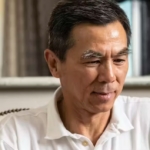| By Susie Ling, Chinese Historical Society of Southern California
March 8, 2007 – So my tween fell in love first. This is a munchkin who grew up on Pokemon, Digimon, Dragon Ball Z, and then graduated to Japanese anime manga. When she sawnaginata – the Japanese “women’s” martial arts with a fierce long staff – she must have fantasized about being a real woman warrior. I am the overworked middle-aged suburban mom who really doesn’t relish driving my daughter to class, waiting on the sidelines, and then driving her back. So I decide to also sign up for this class at our local Japanese American community center. Panic not! I tell myself I will not get involved with my daughter’s exercise; I’ll be a fellow student, not a parent. My tween has since grown up some and transferred her energies to tennis, malls, and Myspace.com. And I’m left loving naginata. They put this six-foot wooden staff in my hand with a simulated bamboo blade and I’m transformed. The weight of the weapon feels right. The wonderful whisper the wood makes as you swing the instrument to the prescribed exercise sings my tune. When I was in high school, I was usually the girl last picked to be on a team in PE class. But I have the rhythm to do this naginata jig. Innaginata culture, you have to kiai (shout) your striking zone. Coincidentally, the kiai for hitting someone on the head is “men”. That’s a weekend dessert after working with the other gender all week. According to Alexander Bennett, naginata dates back to the mid-Heian period (794-1185 CE) in Japanese history. The long blade was in its heyday as a battlefield weapon in the 12th century. By the Tokugawa Period,naginata became the preferred weapon of warrior monks and for the self-defense of women. Women found the length of the naginata a balance to men’s superior physical strength. It also has obvious advantages when your opponent is on a horse. Daughters of samurai families included naginata weapons as part of their dowries. Martial arts in the Meiji Period were no match for modern firearms. But martial arts were saved when the Japanese Ministry of Education saw it as a good physical education exercise that helped build nationalism and “Japaneseness”. Naginata became a substitute calisthenics for female high school students along with swimming, kyujutsu(archery), ice skating, and tennis. For a period during the American occupation after World War II, naginata was forbidden. But 1955 saw the inauguration of the All Japan Naginata Federation. And in 1974, the United States Naginata Federation was established. There are naginata federations in Australia, Brazil, Canada, Western Europe, and even Sweden. I started as a wild woman seeking revenge for all injustices done to my sisters. Pity my opponent. Sensei (teacher) kept suggesting my swings were too wide. But the grace and art ofnaginata, the inherent Zen, is now creeping in. Could it be that I’m learning that control and patience have their place? Evidently, it’s not about brute strength, but about accuracy based on practice and more practice. Sensei is a physicist, advising, “let the length and weight of the weapon do the work.” Zanshin, a purity of heart and purpose, is demanded. In the beginning, this American thought the beginning ritual of meditation and bowing a silly nuisance. Now I secretly wish we could slow down and add just a few more breaths to our cleansing mokuso (meditation) time. In the beginning, I also thought the hakama uniform seriously cumbersome; now, I fold it lovingly, remembering all that it represents. You know, some traditions have reasons that are logical after all. I’m still a newbie. Some of my classmates have moved on to the next big step: donning thebudo armor for shiai (no idea how to translate). They put on a funny helmet with little wings, protective wear, and really hit each other with their staffs. Many of these men and women have had experience with other forms of martial arts; they better demonstrate the essence of martial arts ethics. I watch with envy from the sidelines. Might I ever develop such quick hand-eye coordination? Will I ever be humble enough to be honorable? More possibly, my arthritis and the incessant demands on my time will win. Nevertheless, I won’t regret having this late opportunity to dance. For more information, see www.naginata.org.
Also by Susie Ling
Susie Ling is Co-editor of Gum Saan Journal, a semi-academic magazine of the Chinese Historical Society of Southern California. For more information on Hanford’s China Alley, see the 2007 issue of Gum Saan Journal at www.chssc.org. Photos included here used courtesy of Susie Ling. |
||
|










